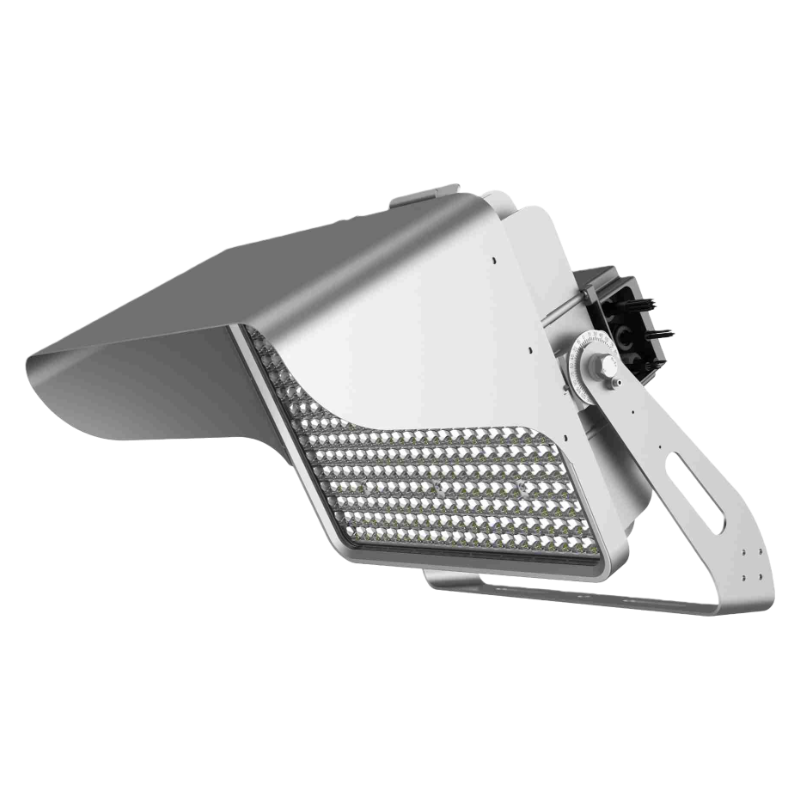#Future of Sports Lighting ·
#LED Sports Lights ·
#LED Stadium Lights ·
#Sports Venue Lighting ·
#Stadium Lighting ·
What Are LED Sports Lights and Why Are They the Future of Stadium Lighting?
Introduction: The Evolution of Stadium Lighting
Stadiums and sports venues are more than just places to watch games—they’re hubs of energy, entertainment, and community. For decades, lighting has been a critical component of the sports experience, but traditional options like metal halide and high-pressure sodium (HPS) lights have long struggled to meet the demands of modern sports. These fixtures are slow to warm up, energy-inefficient, and produce uneven light that hinders both player performance and spectator viewing. Enter LED sports lights—a transformative technology that’s redefining what stadium lighting can be. Designed specifically for the high-stakes, high-brightness needs of sports venues, LED sports lights offer unmatched performance, efficiency, and flexibility. But what exactly are they, and why are they poised to become the universal standard for stadiums worldwide? This guide answers those questions, breaking down their definition, core benefits, and the reasons they’re the future of sports illumination.
What Are LED Sports Lights?
LED sports lights are specialized high-power lighting fixtures engineered to meet the rigorous requirements of sports venues—from local soccer fields and basketball courts to professional stadiums hosting NFL, MLB, or FIFA events. Unlike generic LED high bays, they’re optimized for uniform light distribution, high intensity, precise beam control, and TV broadcast compatibility. Key features that set them apart include:
-
High Lumen Output:Professional stadiums require 100,000-1,000,000+ total lumens, and LED sports lights deliver individual fixture outputs of 50,000-200,000 lumens—far more than standard LED high bays.
-
Optical Precision:They use advanced lens and reflector systems to produce narrow, targeted beam angles (15°-60°) that direct light exactly onto the playing surface, minimizing glare for players and spectators while reducing light pollution in surrounding areas.
-
Broadcast-Grade Quality:Compliant with international standards like FIFA’s FIH Hockey or UEFA’s stadium lighting requirements, including high Color Rendering Index (CRI ≥ 90) and Color Temperature (5000K-6500K) to ensure accurate color representation for TV cameras and in-person viewing.
-
Durable Construction:Built to withstand outdoor elements (IP65+ rating), extreme temperatures (-40°F to 122°F), and the vibrations of large crowds or nearby speakers.
Key Benefits of LED Sports Lights Over Traditional Lighting
When compared to metal halide, HPS, or fluorescent lights, LED sports lights offer a laundry list of advantages that make them superior for stadiums:
-
Unmatched Energy Efficiency:Traditional metal halide lights convert only 25-30% of energy into light; LED sports lights convert 85-90%, cutting energy costs by 60-70%. A professional stadium with 100 metal halide fixtures (1000W each) spends ~$120,000/year on lighting. Switching to 300W LED sports lights reduces that to ~$36,000/year—saving $84,000 annually.
-
Instant On/Off & No Warm-Up Time:Metal halide lights take 5-10 minutes to reach full brightness and can’t be restarted immediately after turning off (a major issue for game delays or power outages). LED sports lights turn on instantly at full brightness, with no cool-down period—critical for maintaining game flow and spectator engagement.
-
Superior Light Uniformity & Glare Control:Traditional lights produce hotspots and dark spots on the playing surface, leading to uneven visibility. LED sports lights use precision optics to deliver 90%+ uniformity (meaning light intensity varies by less than 10% across the field). Anti-glare designs also reduce eye strain for players, ensuring they can track balls and opponents without distraction.
-
Longer Lifespan & Lower Maintenance:Metal halide bulbs last 10,000-15,000 hours; LED sports lights last 50,000-100,000 hours—equivalent to 5-10 years of heavy use (8 hours/day, 365 days/year). This eliminates the need for frequent bulb replacements (a costly and time-consuming task for stadiums with 50+ fixtures) and reduces maintenance labor costs by 80%.
-
Broadcast & Spectator Experience Enhancement:High CRI (≥90) ensures colors look true-to-life on TV and in person—critical for sports like soccer (where jersey colors matter) or baseball (where tracking the ball is key). LED lights also have no flicker, which prevents camera strobing during live broadcasts, delivering a smoother viewing experience for millions of fans at home.
-
Reduced Light Pollution:Targeted beam angles minimize “light spill” into surrounding neighborhoods, making LED sports lights more environmentally friendly and community-friendly than traditional fixtures that cast light in all directions.
Why LED Sports Lights Are the Future of Stadium Lighting
The shift to LED sports lights isn’t just a trend—it’s a necessity driven by technological advancements, regulatory pressures, and evolving fan expectations. Here’s why they’re the future:
-
Growing Broadcast Demands:4K and 8K TV resolutions require brighter, more uniform lighting than ever before. LED sports lights are the only technology that can consistently meet the strict broadcast standards (e.g., FIFA’s Class 4 for international matches) without compromising on quality. As streaming and high-definition viewing become more prevalent, stadiums must upgrade to LEDs to remain competitive.
-
Sustainability Goals:Governments and sports leagues worldwide are pushing for greener venues. The NFL’s “Green Sports Alliance” and FIFA’s “Sustainability Strategy” encourage stadiums to reduce carbon footprints. LED sports lights align with these goals by cutting energy use and eliminating toxic materials like mercury (found in metal halide bulbs).
-
Smart Lighting Integration:The future of stadiums is smart, and LED sports lights are compatible with IoT systems, allowing for remote control, dimming, and dynamic lighting effects. For example, stadiums can adjust brightness for practice sessions vs. games, or create pre-game light shows to enhance fan engagement. Some advanced systems even sync with scoreboards or music for immersive experiences.
-
Cost-Effectiveness Over Time:While LED sports lights have a higher upfront cost than traditional fixtures, their long lifespan and energy savings deliver a rapid return on investment (ROI). A mid-sized stadium can recoup the upfront cost in 2-3 years, and save millions over the fixture’s 10-year lifespan.
-
Adaptability to Multiple Sports:Many modern stadiums host multiple sports (e.g., a soccer stadium that also hosts concerts or rugby). LED sports lights with adjustable beam angles and brightness can be reconfigured for different events, eliminating the need for separate lighting systems—a flexibility traditional lights can’t match.
Real-World Examples of LED Sports Light Transformations
Major sports venues worldwide are already making the switch to LED sports lights, with impressive results:
-
Case 1: Wembley Stadium (London):Home to England’s national soccer team, Wembley upgraded to LED sports lights in 2017. The new system reduced energy use by 60%, eliminated warm-up time, and improved light uniformity to meet FIFA’s Class 4 broadcast standards. The lights also support dynamic pre-game shows, enhancing the fan experience during major events like the UEFA Champions League final.
-
Case 2: Dodger Stadium (Los Angeles):The MLB’s Los Angeles Dodgers switched to LED sports lights in 2020. The upgrade cut energy costs by $300,000/year, reduced maintenance by 90%, and improved broadcast quality—with cameras capturing crisper, more accurate colors. The lights also have dimming capabilities, allowing the stadium to reduce brightness for practice sessions.
-
Case 3: Local Community Stadium (Chicago):A 5,000-seat community stadium replaced 20 metal halide fixtures with 8 LED sports lights. Energy bills dropped by 75%, and the playing surface now has 95% light uniformity—reducing player injuries from poor visibility. The instant-on feature also eliminated game delays caused by bulb warm-up.
Conclusion: LED Sports Lights—The Clear Choice for Tomorrow’s Stadiums
LED sports lights aren’t just an upgrade to traditional stadium lighting—they’re a revolution. Their combination of energy efficiency, superior light quality, durability, and smart capabilities makes them the ideal solution for modern sports venues, whether professional or community-based. As broadcast technology advances, sustainability becomes more critical, and fan expectations rise, LED sports lights will continue to set the standard for stadium illumination. The future of sports lighting is bright—and it’s LED. For stadium owners and operators, the switch isn’t just a smart business decision; it’s an investment in the fan experience, player performance, and the long-term sustainability of their venue. As more stadiums make the transition, it’s clear that LED sports lights are here to stay—and will shape the future of sports entertainment for decades to come.











